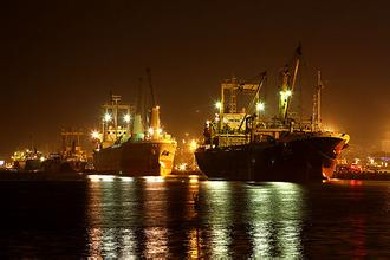The prefix "trans-" means over or to the other side of. Transhipment or transshipment (written with two letter 's')---transit shipment---means a shipment destined to a port or an interior point (location or depot) is best reached by connecting shipment(s) from other port(s) and/or point(s). It is the unloading and reloading of cargo from one means of conveyance to another, in the same or different modes of transportation, during the course of carriage from the place of shipment to the place of destination stipulated in the letter of credit (L/C).
Unless otherwise stipulated in the L/C, transhipment is allowed provided that the entire carriage is covered by one and the same transport document.
Some exporters refuse to accept transhipment because of a belief that it costs more and is slower than a direct shipment. Some importers have the same belief. Contrary to this belief, by using transhipment the cost to certain destinations can be lower and it can be faster than a direct shipment. For instance, the frequency of sailing to a certain destination in a direct shipment is once every two weeks, but by transhipment to the same destination the frequency of sailing can be once or twice weekly. The point in such an instance is that the greater the supply the lower the cost and the earlier the shipment the earlier the importer may receive the goods. In other words, transhipment may save cost and time.
Most ocean freight are containerized in modern shipping. Hence, intermediate reloading of cargo is eliminated in the transhipment, which reduces the cost and time.
The transhipment charge usually is included in the through freight rates, but the shipper must verify with the carrier to ensure that no additional transhipment charge will be collected from the consignee.
Multilateral agreements make the transhipment possible. With worldwide trades and new trading partners on the rise, new routes for transhipment will emerge. For example, trades between Far East and CIS (Commonwealth of Independent States of former Eastern Bloc), the shipment traditionally passes through the Black Sea, but the transit time is shorter by transhipment via the Middle East country (e.g. Iran).
Shipments from Asia and Europe to Central and South America, and vice versa, often require transhipment at ports in North America.
Feeder Vessel and Master Ship
In booking the ocean shipping space with a transhipment, the shipping company provides the names and voyage numbers of the feeder vessel and master ship. The master ship sometimes is referred to as the mother ship. The names and voyage numbers of the feeder vessel and master ship are entered in the ocean bill of lading.
Transhipment in Landlocked Countries
Certain countries are landlocked and so are inaccessible by deep-sea ocean vessels. Import and export goods must be transhipped in other country(ies) by means of truck and/or rail and/or inland waterway (river, canal or lake) transports. Please see some of the landlocked countries in the Landlocked Countries and Transhipping Points.








